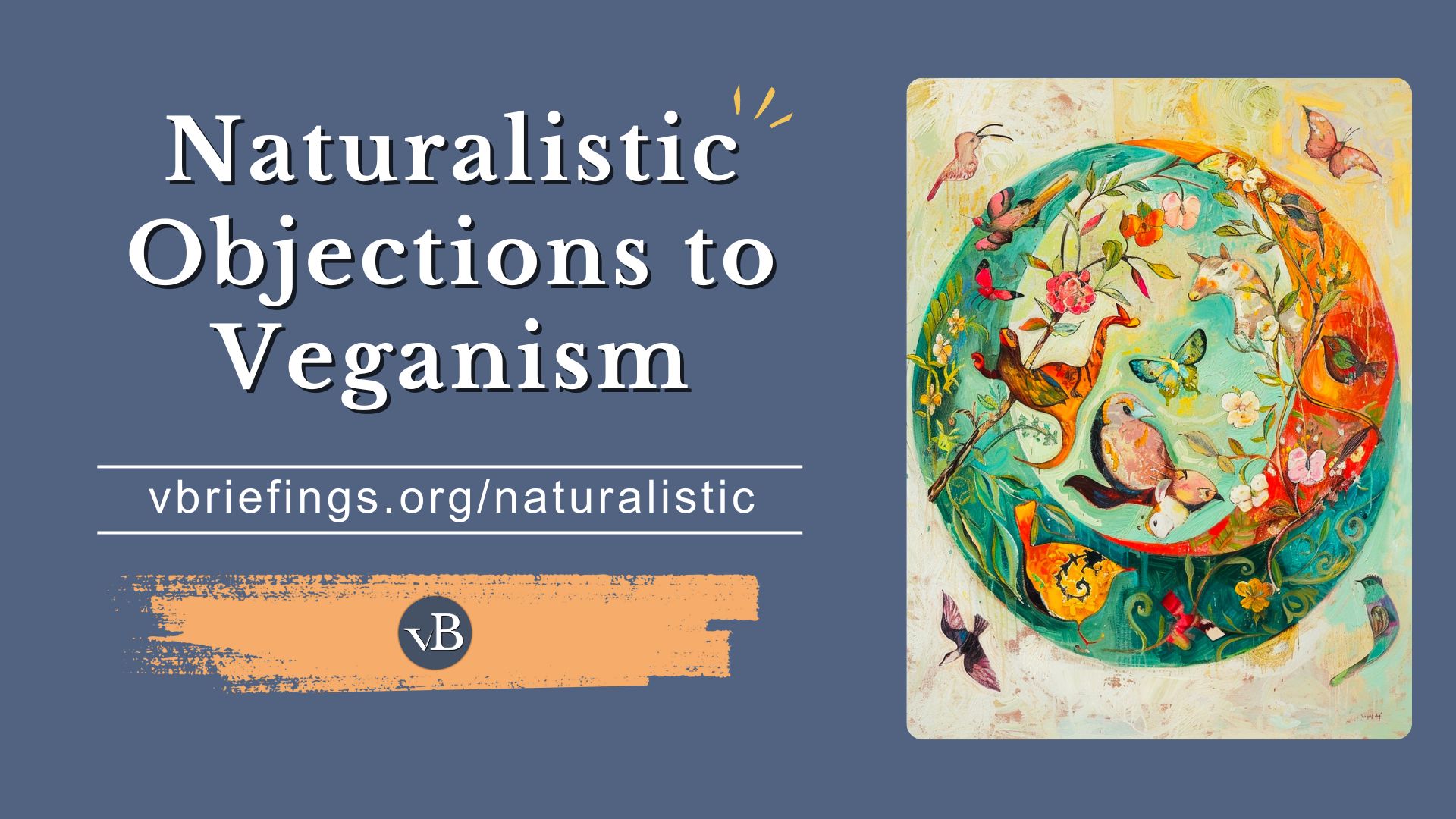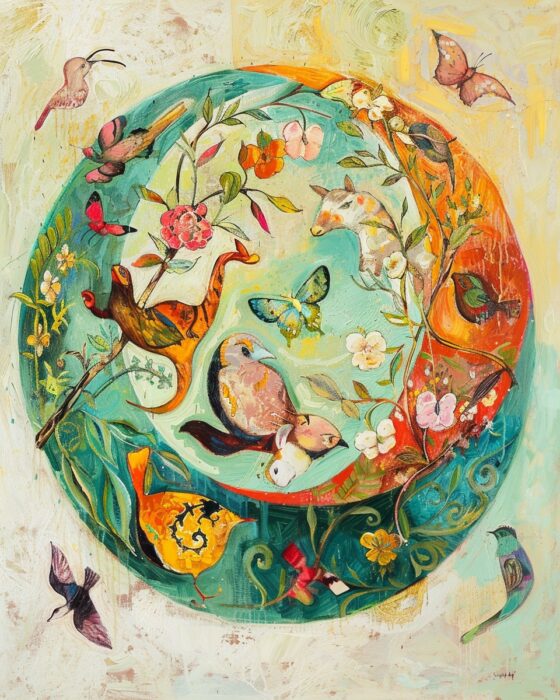Preface
Briefing description and more.
We examine several naturalistic objections to veganism, including “circle of life,” “apex predation,” “animals eat animals,” etc.
Companion Videos
How to use companion videos
Videos may be posted on multiple social media platforms, and you can share them on each platform according each platform’s conventions.
Share this Briefing
Social Media Sharing Image
This image will be used when sharing the briefing on a social media platform. You can see all social sharing images in the grid view.

How to share this briefing
Click on the icon for the platform on which you wish to share. What happens next depends on the platform, but generally a popup will appear, letting you add your own text as you share.
Briefing Meta
Metrics
Note: we will publish additional briefings after completing flashcards and presentation slides for selected briefings.
Counts:
| Main Text | |
| Key Points | 8 |
| Counterclaims | 0 |
| Supplementary | 1 |
| Further Study | 3 |
| Footnotes | 10 |
| Media & Advocacy | |
| Advocacy Notes | 12 |
| —Socratic Questions | 20 |
| Flashcards | 0 |
| Presentation Slides | 0 |
| Memes & Infographics | 0 |
| Companion Videos | 0 |
Other Meta:
Date Posted:
Last Edited:
Edit Log:
Key Points Links
Loading…
Help Us Improve
Please send your suggestions for improvements, or report any issues with this briefing to team@vbriefings.org
We appreciate that you are taking the time to help up improve. All suggestions and reports will be carefully considered.
Summary
A concise summary of the briefing (see below for citations).
The argument that eating animals is natural fails to legitimize the injustices and suffering it causes, often relying on the naturalistic fallacy or the appeal to nature fallacy that equates natural with ethical. Actions like unnecessary violence or theft occur in nature but are not ethically acceptable in the context of human moral agency. Furthermore, animal agriculture is highly unnatural, relying on artificial breeding and disrupting ecological balance, with farmed animals so altered they would struggle to survive in the wild. Humans, placed at a lower trophic level by scientific studies, possess the moral agency to make ethical choices and should not excuse harmful behaviors as “natural.”
Context
Places this topic in its larger context.
In objecting to veganism and animal rights, some invoke a series of statements centering around the idea that eating animals and their milk and eggs is natural.
These statements often reference the circle of life, apex predation, the fact that animals eat other animals, or the assertion that humans are on top of the food chain—all in an attempt to prove that the eating of animal flesh, chickens’ eggs, and cow’s milk by humans is as natural as the laws of physics.
Here we show that these declarations are not germane to the case for veganism. But even if they were, they are still defeated by taking a closer look at the assertions, which we do. Most employ the appeal to nature fallacy or the naturalistic fallacy.
Key Points
This section provides talking points.
Assertions as to what is natural are not pertinent to the validity of veganism.
Simply put, the case for veganism is that it’s wrong to cause unnecessary harm to animals.
Eating products made from animals harms animals, and because we don’t need animal products to be healthy, the harm is unnecessary.
So even if the practice of eating animals were natural, even if it were part of circle of life, even if we were apex predators on top of the food chain, and even though animals do eat other animals—all that still does not justify causing unnecessary harm to others.
As humans, we possess moral agency—the capacity to make ethical choices and to act on them. This ability obligates us to consider the consequences of our actions on other sentient beings and to choose paths that minimize harm and respect their welfare.
Naturalness says nothing about morality.
The occurrence of a behavior in the natural world says nothing about the morality of the behavior.
Rape, defined as forced sexual intercourse, is not unusual in other species. Some species of amphibians, reptiles, birds, fish, and mammals engage in the practice.1
Infanticide is committed by dolphins, lions, and baboons.2
We would not say these behaviors are moral, but we cannot deny that they are natural in the sense that they occur in nature.
Animal agriculture is the antithesis of the circle of life concept.
In broad terms, the circle of life concept is a bit hazy, but it generally encompasses the ideas of predation, decomposition, reproduction, and ecological balance. Animal agriculture is a perversion of all those concepts.
With animal agriculture, there is no natural predation in the wild. Instead, we have slaughterhouses and the killing of wild animal populations for the benefit of ranchers.
With animal agriculture, there is no natural decomposition in the wild as there is with the natural decay of the remains of dead animals in the wild.
With animal agriculture, there is no reproduction in the wild. Instead, it is carefully controlled, often with artificial insemination.
With animal agriculture, there is no ecological balance. Instead, it’s a major force in the destruction of the environment and its ecological balance.
- A 2018 study titled “The biomass distribution on Earth” published in the Proceedings of the National Academy of Sciences (PNAS), as analyzed by Our World in Data, revealed the following”:3
- Of all the mammal biomass on Earth, 62% is farm animals, 34% is humans, and 4% is wild animals.
- The total weight of chickens on farms is approximately 2.5 times the total weight of all wild birds.
- Humans and livestock combined outweigh wild mammals by about 24 to 1.
- As an indication of just how destructive animal agriculture is to our ecological balance, the United Nation Environment Programme (UNEP) said “our use of animals as a food-production technology has brought us to the verge of catastrophe.”4
There is nothing natural about our production of meat, dairy, and eggs.
Selective breeding has resulted in farmed animals that produce far more flesh, far more eggs, and far more milk than their forebears would produce in a natural environment.
- Dairy cows produce more than three times the amount of milk they did several decades ago, which burdens them and results in their development of unnaturally large udders.5
- An egg-laying hen produces more than 300 eggs per year, but the jungle fowl from which they were bred lay four to six eggs in a year.6
- Also, laying hens are bred to lay large eggs, which they are not evolved for; this stresses their reproductive system and causes such problems as osteoporosis, bone breakage, and uterus prolapse.7
- The modern broiler chicken is unnaturally large and has been bred to grow at an unnaturally fast rate and have large breasts.This selective breeding causes numerous afflictions: leg disorders; skeletal, developmental, and degenerative diseases; heart and lung problems; breathing difficulty; and premature death.8
Farmed animals are far from natural—they could not survive in a natural environment. In our contrived animal agriculture system, the concepts of “natural,” “circle of life,” “apex predation,” and “food chain” simply don’t apply.
This selective breeding has made it likely that farmed animals would have difficulty surviving in the wild.
Because of this, the fact that animals in the wild eat other animals in the wild is also irrelevant.
Basing our morality on animal behavior is problematic
Humans have moral agency, meaning we can judge the consequences of our actions.
This implies a degree of responsibility, or duty, to do what is right.
It seems that most people believe that nonhuman animals lack the ability to fully contemplate the moral consequences of their actions.9
Even if non-human animals had moral agency, that does not mean we should model our morality on the behaviors of other species.
We should use our moral agency to make ethical decisions, not invoke nebulous and impertinent concepts of what is natural to justify behaviors that unnecessarily harm others.
It’s a food web, not a chain, and humans are not apex predators in the food web.
Scientists speak mainly in terms of a food web, not a hierarchical food chain.
A study published in the Proceedings of the National Academy of Scientists examined trophic levels, which are used to describe the composition of food consumed, to determine that humans “cannot be considered apex predators” (2013, PNAS).10
Natural predators, apex or not, have physical characteristics that allow them to seize and kill their prey, rip and tear their prey’s flesh, and then eat the raw flesh. Humans lack the ability to do this without tools.
It’s not logical to use other’s circumstances to justify our actions under different circumstances.
The fact that in some situations a human might need to eat an animal for survival does not justify eating an animal when it is not necessary.
Most of us have a plethora of breads, grains, vegetables, fruits, nuts, and seeds along with other plant-based foods readily available.
Animals that eat other animals do not have a choice.
Animals that eat other animals do not have a choice.
- If they are obligate carnivores, then they must eat animals for nutrition.
- If they are omnivores, then they are eating what is available to survive.
Most humans reading this, on the other hand, have available a wide variety of fruits, vegetables, grains, nuts, seeds, and legumes. And humans do not need to eat animals for nutrition.
Counterclaims
Responses to some yes but retorts.
Counterclaims are often not included in objection-type briefings because the objection itself functions as a form of counterargument.
Supplementary Info
Additional information that may prove useful.
Differences in the naturalistic fallacy and the appeal to nature fallacy.
- The appeal to nature fallacy is about evaluating something’s goodness or badness based on its naturalness (often in health or lifestyle debates).
- The naturalistic fallacy is about deriving moral “oughts” from natural “is” (often in ethical and philosophical arguments).
- The appeal to nature fallacy is often a subset of the broader naturalistic fallacy.
- Both falsely assume that nature provides moral or qualitative guidance.
Further Study
Sources providing a deeper understanding of the topic or related topics.
Other Resources
Article: Wikipedia: Appeal to Nature Fallacy
Article: Wikipedia: Naturalistic Fallacy
Advocacy Resources
Information to help with outreach and advocacy.
Note: we will publish additional briefings after completing flashcards and presentation slides for selected briefings.
Share This Briefing
Cloned from the Preface Section on page load.
Companion Videos
Cloned from the Preface Section on page load.
Memes and Infographics
No images found.
How to use Memes and Infographics
To sequence through all memes and infographics on this page, click on any image than use the arrow keys or the arrow buttons to show next and previous images.
To share a meme or infographic, right click on the image and choose download or save as. Then upload the image to the platform of choice.
Presentation Slides
Slides not available.
How to Use the Presentation Slides
You can view the slideshow full screen by clicking on the first link above.
To use Canva presenter mode, view the speaker notes, or download the slides as PowerPoint, login to Canva (the free account works) and follow the Full Canva Link provided above.
To copy this presentation to your own Canva project, use the Full Canva Link provided above, then select File->Make a Copy from the upper left. You can build your own unique presentation from multiple briefings by copying the presentation from each briefing and then building another presentation from the copied presentations.
Flash Cards
We partner with Brainscape because of their excellent features for learning. You will need to create a free Brainscape account to study the cards.
Go to Flash Cards: This will take you to a list of decks.
About Flash Cards and Brainscape
Flash cards are here to help you commit important facts and concepts in this briefing to memory.
In Brainscape, there is one deck for each briefing. You can study more than one deck at a time. Brainscape uses spaced repetition to promote memory retention. It is “the secret to learning more while studying less.”
You can study using your browser, but Brainscape also has a free mobile app that makes learning anywhere easy.
Socratic Questions
Socratic-style questions are embedded in the Advocacy Notes below, and shown in italics.
These are open-ended, thought-provoking questions designed to encourage critical thinking, self-reflection, and deeper understanding. They are inspired by the Socratic method, a teaching technique attributed to the ancient Greek philosopher Socrates, who would ask his students probing questions rather than directly providing answers.
The goal is to help people examine their beliefs, clarify their thoughts, uncover assumptions, and explore the evidence and reasoning behind their ideas.
Advocacy Notes
Tips for Advocacy and Outreach
General Tips
Many people argue against veganism by claiming that eating animals is natural—appealing to nature, the food chain, or predator behavior as justification. Your goal is to help them see why these arguments are flawed, irrelevant, and fail to justify unnecessary harm.
Reframe the conversation. The issue isn’t about what’s natural—it’s about what’s ethical.
Shift the Focus from What’s Natural to What’s Ethical
People may assume that because something occurs in nature, it is morally justified. Challenge this assumption.
- “If something happens in nature, does that automatically make it ethical for humans to do the same?”
- “Many things occur in nature—violence, infanticide, and forced mating. Would you say those are ethical simply because they happen?”
Why? This forces them to acknowledge that naturalness does not determine morality.
Show That Humans Have Moral Agency
Unlike other animals, humans can make ethical decisions based on reasoning rather than survival instinct.
- “If we justify our actions based on what other animals do, should we also adopt their behaviors, like stealing or killing the weak?”
- “Since we can reflect on the consequences of our choices, shouldn’t we choose the least harmful option?”
Why? This highlights that moral responsibility, not instinct, should guide our choices.
Challenge the Claim That Animal Agriculture Resembles the “Circle of Life”
Many argue that eating animals follows the natural cycle of life. Show them why factory farming is the opposite of natural.
- “In the wild, predators hunt, kill, and eat their prey. How is this comparable to factory farms where animals are artificially bred, confined, and slaughtered by machines?”
- “If the circle of life includes ecological balance, why does animal agriculture cause mass deforestation, species extinction, and pollution?”
Why? This reveals that industrial farming is unnatural and disrupts ecosystems rather than maintaining balance.
Expose That Farmed Animals Are Not “Natural”
Many believe eating farmed animals is natural, but these animals are selectively bred to the point of extreme unnaturalness.
- “If farmed animals were natural, why have they been selectively breed to such an extent that they can’t survive in the wild?”
- “Since chickens now grow unnaturally large and cows are bred to produce excessive milk, does that still seem like a natural process?”
Why? This makes them question whether industrially raised animals fit into the “natural” argument.
Address the “Apex Predator” Argument
Some claim humans are apex predators because we eat animals. Show them why this is problematic.
- “If humans were apex predators, why do we need tools to hunt and process our food, unlike real predators?”
- “Why do scientific studies classify humans as having a low trophic level, closer to herbivores than carnivores?”
Why? This challenges the misconception that humans are biologically designed as top predators.
Challenge the Idea That Eating Animals Is Necessary for Survival
Some argue that eating animals is justified because some humans have historically needed to do so.
- “In survival situations, people have eaten human flesh—does that mean it’s justified for us to do it in normal circumstances?”
- “If we have access to plant-based foods that provide all necessary nutrients, why cling to survival-based justifications?”
Why? This reveals that necessity does not justify routine choices in a modern world of abundance.
Expose the Contradiction in Using Other Animals as Moral Models
People cite animal behavior to justify eating meat but reject other behaviors animals exhibit.
- “If we base our morality on what animals do, should we also justify stealing, forced mating, and infanticide?”
- “Why pick only the behaviors that support eating animals and ignore the ones that contradict human morality?”
Why? This forces them to confront their selective reasoning.
Explain That Humans Eat Animals by Cultural Habit, Not Biology
Some assume eating animals is natural because it has been done for centuries. Show that culture, not biological necessity, drives the practice.
- “If eating animals were purely natural, why do different cultures have vastly different diets, many of which don’t include much animal consumption?”
- “Since we can thrive without eating animals, isn’t the choice to do so based on habit rather than necessity?”
Why? This makes them question whether eating animals is an inherent human trait or a learned behavior.
Highlight That the Food Chain Is a Web, Not a Hierarchy
Some argue humans are on top of the food chain, which justifies eating animals. Show them that this is a misrepresentation of ecology.
- “If the food chain is about survival relationships, why do scientists describe it as a food web rather than a linear chain?”
- “Since humans eat plants and animals, but also rely on bacteria and fungi to survive, does that really make us ‘on top’?”
Why? This disrupts the misconception that the food chain justifies eating animals.
Leave Them With a Thought-Provoking Question
If they resist, don’t argue—leave them with something to consider.
- “If a behavior being natural made it moral, wouldn’t we have to accept all kinds of harm just because they occur in nature?”
- “Now that you know animal agriculture is unnatural, unnecessary, and harmful, does the ‘it’s natural’ argument still hold up?”
Why? A strong question stays with them long after the conversation ends.
Footnotes
Our sources, with links back to where they are used.
- Palmer, Craig T. “Rape in Nonhuman Animal Species: Definitions, Evidence, and Implications.” Journal of Sex Research26, no. 3 (August 1989): 355–74. Accessed 2022-06-26 ↩︎
- Thompson, Helen. “Why Some Mammals Kill Babies of Their Own Kind.” Smithsonian, November 13, 2014. ↩︎
- Hannah Ritchie (2022) – “Wild mammals make up only a few percent of the world’s mammals” Published online at OurWorldinData.org. ↩︎
- UNEP Article 2018, “Tackling the world’s most urgent problem: meat,” Accessed 2022-05-21 ↩︎
- Blayney, Don P. The Changing Landscape of US Milk Production. US Department of Agriculture, Economic Research Service, 2002. ↩︎
- Cheng, H.-W. “Breeding of Tomorrow’s Chickens to Improve Well-Being.” Poultry Science 89, no. 4 (April 1, 2010): 805–13. ↩︎
- Jamieson, Alastair. “Large Eggs Cause Pain and Stress to Hens, Shoppers Are Told,” March 11, 2009, sec. Finance. ↩︎
- Stevenson, Peter. “Leg and Heart Problems in Broiler Chickens.” Compassion in World Farming, January 2003. ↩︎
- Regan, Tom. The Case for Animal Rights. University of California Press, 2004. 152-154 ↩︎
- Proceedings of the National Academy of Science), Eating up the world’s food web and the human trophic level.) Accessed 2022-06-26 ↩︎




